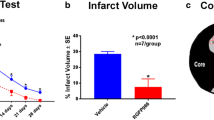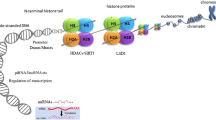Abstract
Understanding how epigenetics influences the process and progress of a stroke could yield new targets and therapeutics for use in the clinic. Experimental evidence suggests that inhibitors of zinc-dependent histone deacetylases can protect neurons, axons, and associated glia from the devastating effects of oxygen and glucose deprivation. While the specific enzymes involved have yet to be clearly identified, there are hints from somewhat selective chemical inhibitors and also from the use of specific small hairpin RNAs to transiently knockdown protein expression. Neuroprotective mechanisms implicated thus far include the upregulation of extracellular glutamate clearance, inhibition of p53-mediated cell death, and maintenance of mitochondrial integrity. The histone deacetylases have distinct cellular and subcellular localizations, and discrete substrates. As a number of chemical inhibitors are already in clinical use for the treatment of cancer, repurposing for the stroke clinic should be expedited.







Similar content being viewed by others
References
Go AS, Mozaffarian D, Roger VL, et al. Heart disease and stroke statistics—2013 update. Circulation 2013;127:e6–e245.
Sun J, Sun J, Ming G-l, Song H. Epigenetic regulation of neurogenesis in the adult mammalian brain. Europ J Neurosci 2011;33:1087–1093.
Qureshi IA, Mehler MF. The emerging role of epigenetics in stroke. III Neural stem cell biology and regenerative medicine. Arch Neurol 2011;68:294–302.
Rodríguez-Paredes M, Esteller M. Cancer epigenetics reaches mainstream oncology. Nat Med 2011;17:330–339.
Pearce WJ. Epigenetics: an expanding new piece of the stroke puzzle. Transl Stroke Res 2011;2:243–247.
Qureshi IA, Mattick JS, Mehler MF. Long non-coding RNAs in nervous system function and disease. Brain Res 2010;1338:20–35.
Dharap A, Nakka VP, Vemuganti R. Effect of focal ischemia on long noncoding RNAs. Stroke 2012;43:2800–2802.
Kaur P, Liu F, Rong et al. Non-coding RNAs as potential neuroprotectants against ischemic brain injury. Brain Sci 2013;3:360–395.
Qureshi IA, Mehler MF. The emerging role of epigenetics in stroke II. RNA regulatory circuitry. Arch Neurol 2010;67:1435–1441.
Liu D-Z, Tian Y, Ander BP et al. Brain and blood microRNA expression profiling of ischemic stroke, intracerebral hemorrhage, and kainate seizures J Cereb Blood Flow Metab 2010;30:92–101.
Ouyang YB, Stary CM, Yang GY, Giffard R. MicroRNAs: Innovative targets for cerebral ischemia and stroke. Curr Drug Targets 2013;14:90–101.
Wang Y, Wang Y, Yang G-Y. MicroRNAs in cerebral ischemia. Stroke Res Treat 2013 ID 276540.
Rink C, Khanna S. MicroRNA in ischemic stroke etiology and pathology. Physiol Genom 2011;43:521–528.
Qureshi IA, Mehler MF. Emerging role of epigenetics in stroke. Part 1: DNA methylation and chromatin modifications. Arch Neurol 2010;67:1316–1322.
Baltan S, Bachleda A, Morrison RS, Murphy SP. Expression of histone deacetylases in cellular compartments of the mouse brain and the effects of ischemia. Trans Stroke Res 2011;2:411–423.
Baltan S, Besancon EF, Mbow B, Ye, ZC, Hamner M, Ransom BR. White matter vulnerability to ischemic injury increases with age due to enhanced excitotoxicity. J Neurosci 2008;28:1479–1489.
Gibson CL, Murphy SP. Benefits of histone deacetylase inhibitors for acute brain injury: a systematic review of animal studies. J Neurochem 2010;115:806–813.
Wang Z, Leng Y, Tsai L-K, Leeds P, Chuang D-M. Valproic acid attenuates blood–brain barrier disruption in a rat model of transient focal cerebral ischemia: the roles of HDAC and MMP-9 inhibition. J Cereb Blood Flow Metab 2011:31;52–57.
Wang B, Zhu X, Kim YT, et al. HDAC inhibition activates transcription factor Nrf2 and protects against cerebral ischemic damage. Free Rad Biol Med 2012;52:928–936.
He M, Zhang B, Wei X, Wang Z, Fan B, Du P, et al. HDAC4/5-HMGB1 signaling mediated by NADPH oxidase activity contributes to cerebral ischaemia/reperfusion injury. J Cell Mol Med 2013;17:531–542:
Del Zoppo GJ. Why do all drugs work in animals but none in stroke patients? 1. Drugs promoting cerebral blood flow. J Intern Med 1995;237:79–88.
Del Zoppo GJ. Clinical trials in acute stroke: why have they not been successful? Neurology 1998;51:S59–S61.
Dirnagl U, Iadecola C, Moskowitz MA Pathobiology of ischaemic stroke: an integrated view. Trends Neurosci 1999;22:391–397.
O’Collins VE, Macleod MR, Donnan GA, Horky LL, van der Worp BH, Howells DW. 1,026 experimental treatments in acute stroke. Ann Neurol 2006;59:467–477.
Cavallotti C, Pacella E, Pescosolido N, Tranquilli-Leali FM, Feher J. Age-related changes in the human optic nerve. Can J Ophthalmol 2002;37:389–394.
Cavallotti C, Cavallotti D, Pescosolido N, Pacella E. Age-related changes in rat optic nerve:morphological studies. Anat Histol Embryol 2003;32:12–16.
Baltan S, Murphy SP, Danilov AC, Bachleda A, Morrison R. Histone deacetylase inhibitors preserve white matter structure and function during ischemia by conserving ATP and reducing excitotoxicity. J Neurosci 2011;31:3990–3999.
Baltan S. Histone deacetylase inhibitors preserve function in aging axons. J Neurochem 2012;123(Suppl. 2):108–115.
Baltan S. Ischemic injury to white matter: An age-dependent process. Neuroscientist 2009;15:126–133.
Tekkok SB, Ye ZC, Ransom BR. Excitotoxic mechanisms of ischemic injury in myelinated white matter. J Cereb Blood Flow Metab 2007;27:1540–1552.
Rothstein JD, Dykes-Hoberg M, Pardo CA, et al. Knockout of glutamate transporters reveals a major role for astroglial transport in excitotoxicity and clearance of glutamate. Neuron 1996;16:675–686.
Acheson A, Conover JC, Fandl JP, et al. A BDNF autocrine loop in adult sensory neurons prevents cell death. Nature 1995;374:450–453.
Huang EJ, Reichardt LF. Neurotrophins: Roles in neuronal development and function. Annu Rev Neurosci 2001;24:677–736.
Yasuda S, Liang MH, Marinova Z, Yahyavi A, Chuang DM. The mood stabilizers lithium and valproate selectively activate the promoter IV of brain-derived neurotrophic factor in neurons. Mol Psych 2009;14:51–59.
Liu XS, Chopp M, Kassis H, et al. Valproic acid increases white matter repair and neurogenesis after stroke. Neuroscience 2012;220:313–321.
Wang Z, Tsai LK, Munasinghe J, et al. Chronic valproate treatment enhances postischemic angiogenesis and promotes functional recovery in a rat model of ischemic stroke. Stroke 2012;43:2430–2436.
Fass DM, Reis SA, et al. Crebinostat: a novel cognitive enhancer that inhibits histone deacetylase activity and modulates chromatin-mediated neuroplasticity. Neuropharmacology 2013;64:81–96.
Chen SH, Wu HM, Ossola B, et al. Suberoylanilide hydroxamic acid, a histone deacetylase inhibitor, protects dopaminergic neurons from neurotoxin-induced damage. Br J Pharmacol 2012;165:494–505.
Martín-Montalvo A, Villalba JM, Navas P, de Cabo R. NRF2, cancer and calorie restriction. Oncogene 2011;30:505–520.
Son TG, Camandola S, Arumugam TV, et al. Plumbagin, a novel Nrf2/ARE activator, protects against cerebral ischemia. J Neurochem 2010;112:1316–1326.
Morrison R, Kinoshita Y, Johnson MD, Guo W, Garden GA. p53-dependent cell death signaling in neurons. Neurochem Res 2003;28:15–27.
Uo T, Kinoshita Y, Morrison RS. Apoptotic actions of p53 require transcriptional activation of PUMA and do not involve a direct mitochondrial/cytoplasmic site of action in postnatal cortical neurons. J Neurosci 2007;27:12198–12210.
Langley B, D’Annibale MA, Suh K, et al. Pulse inhibition of histone deacetylases induces complete resistance to oxidative death in cortical neurons without toxicity and reveals a role for cytoplasmic p21waf1/cip1 in cell cycle-independent neuroprotection. J Neurosci 2008;28:163–176.
Chen S, Owens GC, Makarenkova H, Edelman DB. HDAC6 regulates mitochondrial transport in hippocampal neurons. PLoS One 2010;5:e10848.
Dompierre JP, Godin JD, Charrin BC, Cordelières FP, et al.Histone deacetylase 6 inhibition compensates for the transport deficit in Huntington’s disease by increasing tubulin acetylation. J Neurosci 2007;27:3571–3583.
Kim JY, Shen S, Dietz K, He Y, Reynolds R, Casaccia P. HDAC1 nuclear export induced by pathological conditions is essential for the onset of axonal damage. Nat Neurosci 2010;13:180–189.
Wang DB, Garden GA, Kinoshita C, et al. Declines in Drp1 and parkin expression underlie DNA damage-induced changes in mitochondrial length and neuronal death. J Neurosci 2013;33:1357–1365.
Uo T, Veenstra TD, Morrison RS. HDAC inhibitors prevent p53-dependent and -independent Bax-mediate neuronal apoptosis through two distinct mechanisms. J Neurosci 2009;29:2824–2832.
Marinova Z, Ren M, Wendland JR, Leng Y, et al. Valproic acid induces functional heat-shock protein 70 via Class I histone deacetylase inhibition in cortical neurons: a potential role of Sp1 acetylation. J Neurochem 2009;111:976–987.
Leng Y, Liang MH, Ren M, et al. Synergistic neuroprotective effects of lithium and valproic acid or other histone deacetylase inhibitors in neurons: roles of glycogen synthase kinase-3 inhibition. J Neurosci 2008;28:2576–2588.
Bolger TA, Yao TP.Intracellular trafficking of histone deacetylase 4 regulates neuronal cell death. J Neurosci 2005;25:9544–9553.
Yang Y, Qin X, Liu S, et al. Peroxisome proliferator-activated receptor γ is inhibited by histone deacetylase 4 in cortical neurons under oxidative stress. J Neurochem 2011;118:429–439.
Kahle MP, Bix GJ. Neuronal restoration following ischemic stroke: influences, barriers, and therapeutic potential. Neurorehabil Neural Repair 2013;27:469–478.
Hsieh J, Nakashima K, Kuwabara T, Mejia E, Gage FH Histone deacetylase inhibition-mediated neuronal differentiation of multipotent adult neural progenitor cells. Proc Natl Acad Sci USA 2004;101:16659–16664.
Balasubramaniyan V, Boddeke E, Bakels R Effects of HDAC inhibition on neuronal differentiation of embryonic mouse neural stem cells. Neuroscience 2006:143; 939–951.
Dovey OM, Foster CT, Cowley SM. Histone deacetylase 1 (HDAC1), but not HDAC2, controls embryonic stem cell differentiation. Proc Natl Acad Sci U S A 2010;107:8242–8247.
Lee S, Lee S-K. Crucial roles of histone-modifying enzymes in mediating neural cell-type specification. Curr Opin Neurobiol 2010;20:29–36.
Montgomery RL, Hsieh J, Barbosa AC, Richardson JA, Olson EN. HDACs 1 and 2 control the progression of neural precursors to neurons during brain development. Proc Natl Acad Sci U S A 2009;106:7876–7881.
Humphrey GW, Wang Y-H, Hirai T, et al. Complementary roles for HDACs 1,2,and 3 in differentiation of pluripotent stem cells. Differentiation 2008;76:348–356.
Kim H J, Rowe M, Ren M, Hong J-S, Chen P-S, Chuang D-M. Histone deacetylase inhibitors exhibit anti-inflammatory and neuroprotective effects in a rat permanent ischemic model of stroke: multiple mechanisms of action. J Pharmacol Exp Ther 2007;321:892–901.
Guan J-S, Haggarty SJ, Giacometti E, et al. HDAC2 negatively regulates memory formation and synaptic plasticity. Nature 2009;459:55–60.
Nott A, Watson PM, Robinson JD, Crepaldi L, Riccio A. S-nitrosylation of HDAC2 induces chromatin remodeling in neurons. Nature 2008;455:411–415.
Acknowledgments
We thank past and present members of our laboratories for their many contributions. Continuing grant funding is from NIH-NIA/NINDS, American Heart Association, and American Stroke Association. The authors declare no conflicts of interest.
Required Author Forms
Disclosure forms provided by the authors are available with the online version of this article.
Author information
Authors and Affiliations
Corresponding author
Electronic supplementary material
Below is the link to the electronic supplementary material.
ESM 1
(PDF 510 kb)
Rights and permissions
About this article
Cite this article
Baltan, S., Morrison, R.S. & Murphy, S.P. Novel Protective Effects of Histone Deacetylase Inhibition on Stroke and White Matter Ischemic Injury. Neurotherapeutics 10, 798–807 (2013). https://doi.org/10.1007/s13311-013-0201-x
Published:
Issue Date:
DOI: https://doi.org/10.1007/s13311-013-0201-x




